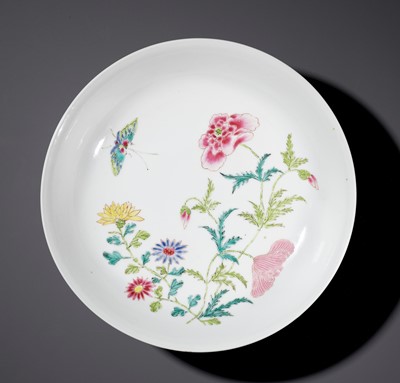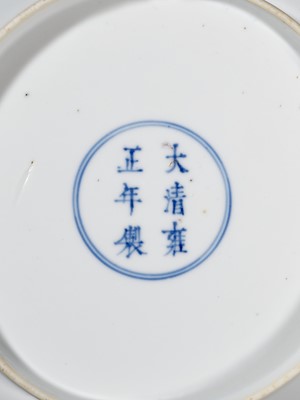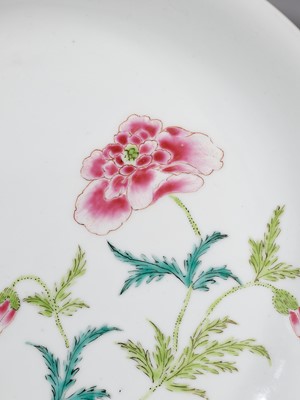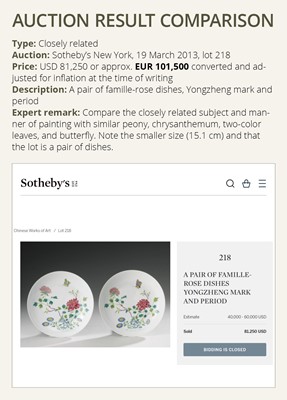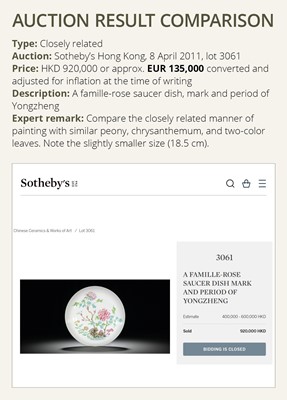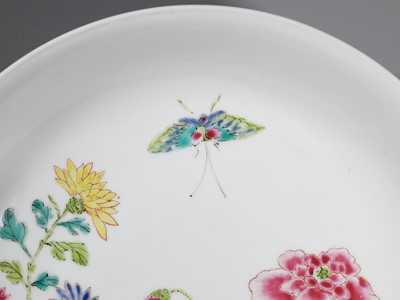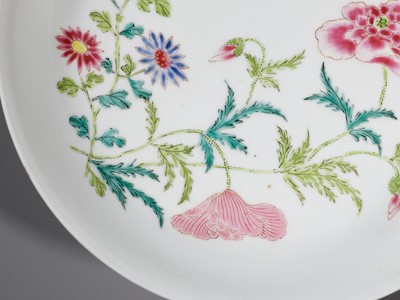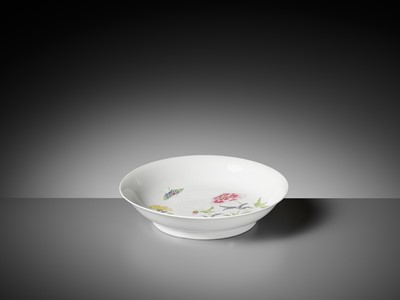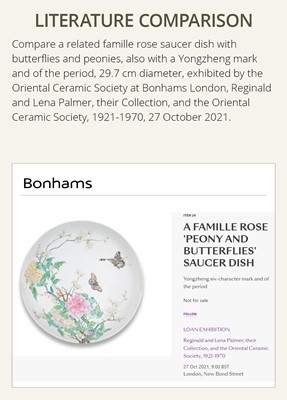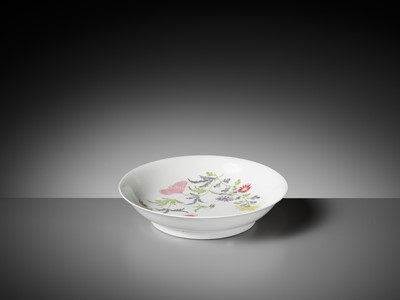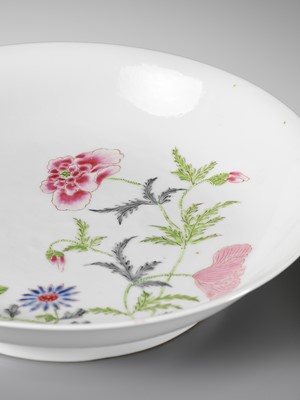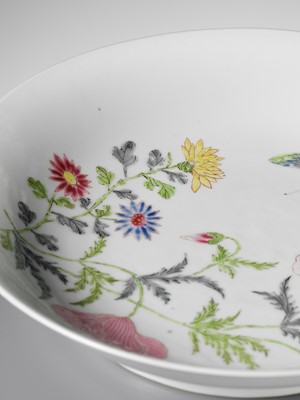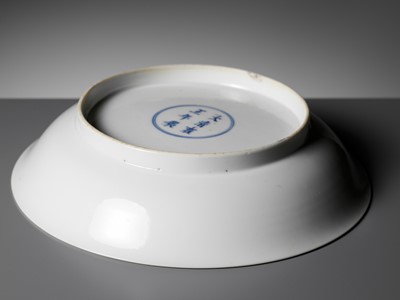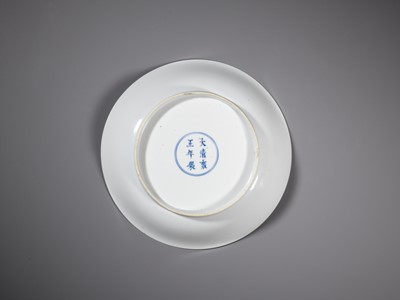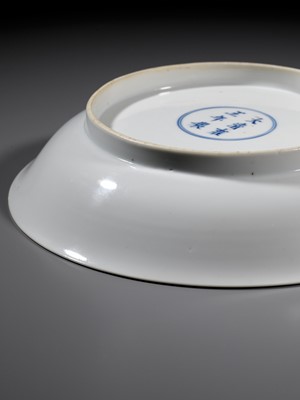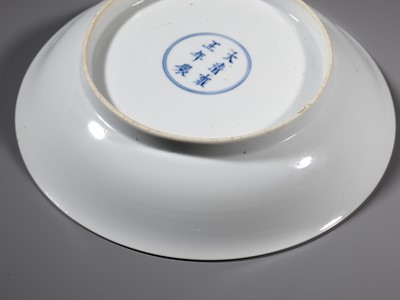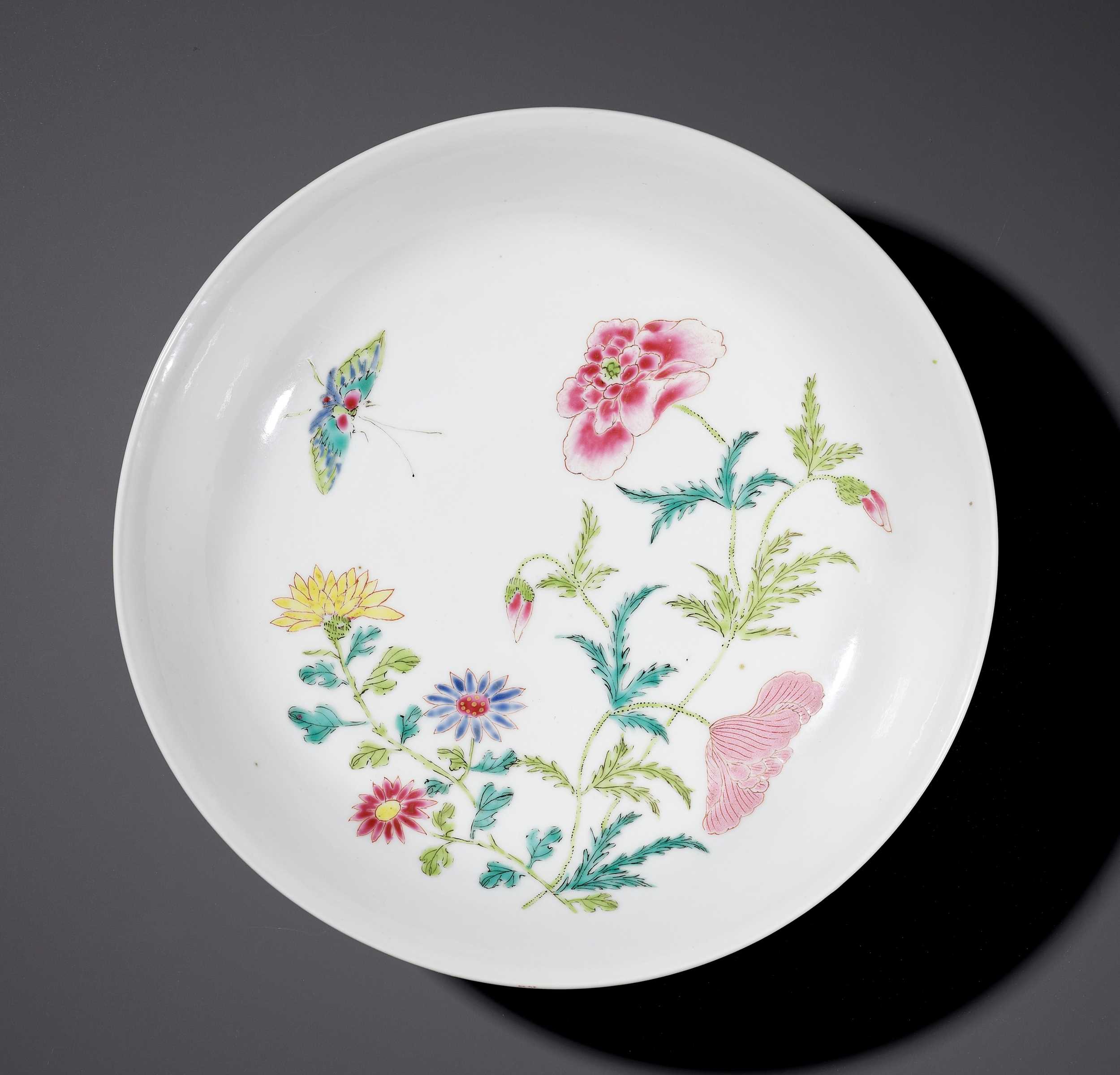29th Sep, 2022 13:00
DAY 1 - TWO-DAY AUCTION - Fine Chinese Art / 中國藝術集珍 / Buddhism & Hinduism
77
A FAMILLE ROSE ‘BUTTERFLY AND FLOWERS’ SAUCER DISH, YONGZHENG MARK AND PERIOD
雍正款及年代粉彩花蝶戀紋小碟
Sold for €19,500
including Buyer's Premium
Opinion: It has become exceedingly difficult to find 18th century ‘boneless’ wares in a good state of preservation, regardless of form or size. But being able to offer such a large dish, with such a finely painted Yongzheng mark, and from the period, with such vibrant colors, and in such pristine condition overall, just feels like a once-in-a-lifetime event!
China, 1723-1735. Delicately potted, the shallow rounded sides rising from a straight and high foot to a gently everted rim. The interior finely painted in ‘boneless style’ with bright enamels to depict a butterfly fluttering amid leafy and flowering stems of chrysanthemum and peony with two still-closed buds. The recessed base with an underglaze-blue six-character mark da Qing Yongzheng nianzhi within a double circle and of the period.
Provenance: A Scottish private collection.
Condition: Magnificent condition commensurate with age. Only minor old wear and tiny firing irregularities. The foot rim with two minor nicks. A Yongzheng-era porcelain dish in such well-preserved condition must be considered extremely rare.
Weight: 256.9 g
Dimensions: Diameter 19.8 cm
The combination of flowers and butterflies to decorate Chinese porcelain can be seen from as early as the Ming dynasty's Yongle reign, when it was used on blue and white wares, such as the pear-shaped vase in the Sir Percival David collection, British Museum, London, illustrated by R. Scott, Elegant Form and Harmonious Decoration: Four Dynasties of Jingdezhen Porcelain, London, 1992, p. 38, no. 25. The combination of butterflies and flower sprays painted in overglaze enamels on porcelain, however, became particularly popular at the Imperial Court during the Yongzheng reign, following the development of the famille rose palette of enamel colors, see a famille rose bowl, Yongzheng mark and period, decorated with roundels enclosing butterflies and flowers, illustrated in The Complete Collection of Treasures of the Palace Museum. Porcelains with Cloisonné Enamel Decoration and Famille Rose Decoration, vol. 39, Hong Kong, 1999, pp. 78-9, no.68.
This bowl is an early example of the new confidence among painters during the reign of Yongzheng to increasingly handle areas of multiple color without using formal borders for separation. This technique is known as 'boneless style', because there virtually is no inner skeleton to the design. In the present lot for example, the pink and white colors of the large peony flower are not separated by any lines. This technique was not widely used, most likely because it was too difficult to implement on a mass production scale. It represented a great challenge to the artists, where unskilled painters would require outlines to complete their sections of decoration, and if not handled well, would give the impression that the piece was unfinished.
The fluttering butterfly depicted on this dish emphasizes the fragile, shimmering beauty of the wings. Designs of butterflies suggest duplication of an auspicious wish, since the character for butterfly is a homophone for 'repeat'. It also is a homophone with ‘die’ meaning 'Over seventy or eighty years of age', and thus expresses a wish for longevity. Butterflies also symbolize happiness in marriage and everlasting romantic love. The latter interpretation is due to a number of traditional Chinese stories in which butterflies play a significant part. Feng Menglong (1574-1646), for example, narrates the popular story of the ‘butterfly lovers’ Liang Shanbo and Zhu Yingtai, who are transformed into butterflies after death. The philosopher Zhuangzi’s famous dream of being a butterfly also made them symbols of the boundary between dream and reality.
Literature comparison:
Compare a related famille rose saucer dish with butterflies and peonies, also with a Yongzheng mark and of the period, 29.7 cm diameter, exhibited by the Oriental Ceramic Society at Bonhams London, Reginald and Lena Palmer, their Collection, and the Oriental Ceramic Society, 1921-1970, 27 October 2021.
Auction result comparison:
Type: Closely related
Auction: Sotheby’s Hong Kong, 8 April 2011, lot 3061
Price: HKD 920,000 or approx. EUR 135,000 converted and adjusted for inflation at the time of writing
Description: A famille-rose saucer dish, mark and period of Yongzheng
Expert remark: Compare the closely related manner of painting with similar peony, chrysanthemum, and two-color leaves. Note the slightly smaller size (18.5 cm).
Auction result comparison:
Type: Closely related
Auction: Sotheby’s New York, 19 March 2013, lot 218
Price: USD 81,250 or approx. EUR 101,500 converted and adjusted for inflation at the time of writing
Description: A pair of famille-rose dishes, Yongzheng mark and period
Expert remark: Compare the closely related subject and manner of painting with similar peony, chrysanthemum, two-color leaves, and butterfly. Note the smaller size (15.1 cm) and that the lot is a pair of dishes.
雍正款及年代粉彩花蝶戀紋小碟
中國,1723-1735年。胎薄體輕,盤心以沒骨畫法繪牡丹、萱草高低錯落,彩蝶翩翩,畫面生動,風格清新雅緻,敷彩鮮豔。圈足内雙圈青花六字款“大清雍正年製”。
專家注釋:無論形式或大小,都很難找到保存完好的十八世紀沒骨法描繪的器具。此盤描繪精美,雍正款,琺瑯釉彩保存極好,如真是千載難逢的機會。
來源:蘇格蘭私人收藏。
品相:狀況極好,與年齡相稱。只有輕微的磨損和微小瑕疵。足緣有兩個小刻痕。保存如此完好的雍正瓷盤實屬罕見。
重量:256.9 克
尺寸:直徑19.8 厘米
早在明朝永樂年間,就可以看到花卉和蝴蝶的組合紋飾,比如在青花瓷上,可見大英博物館大衛爵士收藏的梨形瓶,倫敦,R. Scott 《Elegant Form and Harmonious Decoration: Four Dynasties of Jingdezhen Porcelain》(優雅的形式與精美的紋飾:歷經四朝的景德鎮瓷器),倫敦,1992 年,頁38,編號25。瓷器上粉彩蝶戀花的組合,在雍正年間尤其流行。《故宮博物院藏文物珍品全集》中雍正款的粉彩碗,開光描繪蝶戀花紋飾,見第39冊《琺瑯彩‧粉彩》,香港,1999年,頁78-9,編號68。
此碗的花卉使用沒骨畫法渲染。牡丹花通過渲染,可見花卉的陰陽向背、濃淡深淺之別,畫面層次感豐富。這種技術沒有被廣泛使用,很可能是因為這種畫法對工匠的繪畫技術要求很高,難以大規模生產。而在繪製飛舞的蝴蝶時又強調了線條以展示其脆弱和閃爍的美麗。
蝴蝶意為“福迭”,有著吉祥幸福的美好寓意。蝶有與“耋”同音,意爲“八十歲”,寓意長壽。蝴蝶也像徵著婚姻的幸福和永恆的浪漫愛情,在很多中國傳統故事中蝴蝶有著極其重要的意義。例如,馮夢龍(1574-1646)講述了梁山伯和祝英台死後化蝶的故事。而莊周夢蝶又是一個著名的哲學問題——人如何認識真實。
文獻比較:
比較一件相近的雍正款及年代粉彩蝴蝶牡丹小碟,直徑29.7 厘米 ,由東方陶瓷學會展出於倫敦邦瀚斯,〈Reginald and Lena Palmer,their Collection〉,見〈東方陶瓷學會,1921-1970〉,2021年10月27日。
拍賣結果比較:
形制:非常相近
拍賣:香港蘇富比,2011年4月8日,lot 3061
價格:HKD 920,000(相當於今日EUR 135,000)
描述:雍正款及年代粉彩蝴蝶牡丹小碟
專家評論:比較非常相近的牡丹畫法、菊花和雙色葉。請注意尺寸稍小 (18.5 厘米)。
拍賣結果比較:
形制:非常相近
拍賣:紐約蘇富比,2013年3月19日,lot 218
價格:USD 81,250(相當於今日EUR 101,500)
描述:一對雍正款及年代粉彩蝴蝶牡丹小碟
專家評論:比較非常相近的主題、牡丹畫法、菊花、雙色葉和蝴蝶。請注意尺寸較小(15.1 厘米),且此碟為一對 。
Opinion: It has become exceedingly difficult to find 18th century ‘boneless’ wares in a good state of preservation, regardless of form or size. But being able to offer such a large dish, with such a finely painted Yongzheng mark, and from the period, with such vibrant colors, and in such pristine condition overall, just feels like a once-in-a-lifetime event!
China, 1723-1735. Delicately potted, the shallow rounded sides rising from a straight and high foot to a gently everted rim. The interior finely painted in ‘boneless style’ with bright enamels to depict a butterfly fluttering amid leafy and flowering stems of chrysanthemum and peony with two still-closed buds. The recessed base with an underglaze-blue six-character mark da Qing Yongzheng nianzhi within a double circle and of the period.
Provenance: A Scottish private collection.
Condition: Magnificent condition commensurate with age. Only minor old wear and tiny firing irregularities. The foot rim with two minor nicks. A Yongzheng-era porcelain dish in such well-preserved condition must be considered extremely rare.
Weight: 256.9 g
Dimensions: Diameter 19.8 cm
The combination of flowers and butterflies to decorate Chinese porcelain can be seen from as early as the Ming dynasty's Yongle reign, when it was used on blue and white wares, such as the pear-shaped vase in the Sir Percival David collection, British Museum, London, illustrated by R. Scott, Elegant Form and Harmonious Decoration: Four Dynasties of Jingdezhen Porcelain, London, 1992, p. 38, no. 25. The combination of butterflies and flower sprays painted in overglaze enamels on porcelain, however, became particularly popular at the Imperial Court during the Yongzheng reign, following the development of the famille rose palette of enamel colors, see a famille rose bowl, Yongzheng mark and period, decorated with roundels enclosing butterflies and flowers, illustrated in The Complete Collection of Treasures of the Palace Museum. Porcelains with Cloisonné Enamel Decoration and Famille Rose Decoration, vol. 39, Hong Kong, 1999, pp. 78-9, no.68.
This bowl is an early example of the new confidence among painters during the reign of Yongzheng to increasingly handle areas of multiple color without using formal borders for separation. This technique is known as 'boneless style', because there virtually is no inner skeleton to the design. In the present lot for example, the pink and white colors of the large peony flower are not separated by any lines. This technique was not widely used, most likely because it was too difficult to implement on a mass production scale. It represented a great challenge to the artists, where unskilled painters would require outlines to complete their sections of decoration, and if not handled well, would give the impression that the piece was unfinished.
The fluttering butterfly depicted on this dish emphasizes the fragile, shimmering beauty of the wings. Designs of butterflies suggest duplication of an auspicious wish, since the character for butterfly is a homophone for 'repeat'. It also is a homophone with ‘die’ meaning 'Over seventy or eighty years of age', and thus expresses a wish for longevity. Butterflies also symbolize happiness in marriage and everlasting romantic love. The latter interpretation is due to a number of traditional Chinese stories in which butterflies play a significant part. Feng Menglong (1574-1646), for example, narrates the popular story of the ‘butterfly lovers’ Liang Shanbo and Zhu Yingtai, who are transformed into butterflies after death. The philosopher Zhuangzi’s famous dream of being a butterfly also made them symbols of the boundary between dream and reality.
Literature comparison:
Compare a related famille rose saucer dish with butterflies and peonies, also with a Yongzheng mark and of the period, 29.7 cm diameter, exhibited by the Oriental Ceramic Society at Bonhams London, Reginald and Lena Palmer, their Collection, and the Oriental Ceramic Society, 1921-1970, 27 October 2021.
Auction result comparison:
Type: Closely related
Auction: Sotheby’s Hong Kong, 8 April 2011, lot 3061
Price: HKD 920,000 or approx. EUR 135,000 converted and adjusted for inflation at the time of writing
Description: A famille-rose saucer dish, mark and period of Yongzheng
Expert remark: Compare the closely related manner of painting with similar peony, chrysanthemum, and two-color leaves. Note the slightly smaller size (18.5 cm).
Auction result comparison:
Type: Closely related
Auction: Sotheby’s New York, 19 March 2013, lot 218
Price: USD 81,250 or approx. EUR 101,500 converted and adjusted for inflation at the time of writing
Description: A pair of famille-rose dishes, Yongzheng mark and period
Expert remark: Compare the closely related subject and manner of painting with similar peony, chrysanthemum, two-color leaves, and butterfly. Note the smaller size (15.1 cm) and that the lot is a pair of dishes.
雍正款及年代粉彩花蝶戀紋小碟
中國,1723-1735年。胎薄體輕,盤心以沒骨畫法繪牡丹、萱草高低錯落,彩蝶翩翩,畫面生動,風格清新雅緻,敷彩鮮豔。圈足内雙圈青花六字款“大清雍正年製”。
專家注釋:無論形式或大小,都很難找到保存完好的十八世紀沒骨法描繪的器具。此盤描繪精美,雍正款,琺瑯釉彩保存極好,如真是千載難逢的機會。
來源:蘇格蘭私人收藏。
品相:狀況極好,與年齡相稱。只有輕微的磨損和微小瑕疵。足緣有兩個小刻痕。保存如此完好的雍正瓷盤實屬罕見。
重量:256.9 克
尺寸:直徑19.8 厘米
早在明朝永樂年間,就可以看到花卉和蝴蝶的組合紋飾,比如在青花瓷上,可見大英博物館大衛爵士收藏的梨形瓶,倫敦,R. Scott 《Elegant Form and Harmonious Decoration: Four Dynasties of Jingdezhen Porcelain》(優雅的形式與精美的紋飾:歷經四朝的景德鎮瓷器),倫敦,1992 年,頁38,編號25。瓷器上粉彩蝶戀花的組合,在雍正年間尤其流行。《故宮博物院藏文物珍品全集》中雍正款的粉彩碗,開光描繪蝶戀花紋飾,見第39冊《琺瑯彩‧粉彩》,香港,1999年,頁78-9,編號68。
此碗的花卉使用沒骨畫法渲染。牡丹花通過渲染,可見花卉的陰陽向背、濃淡深淺之別,畫面層次感豐富。這種技術沒有被廣泛使用,很可能是因為這種畫法對工匠的繪畫技術要求很高,難以大規模生產。而在繪製飛舞的蝴蝶時又強調了線條以展示其脆弱和閃爍的美麗。
蝴蝶意為“福迭”,有著吉祥幸福的美好寓意。蝶有與“耋”同音,意爲“八十歲”,寓意長壽。蝴蝶也像徵著婚姻的幸福和永恆的浪漫愛情,在很多中國傳統故事中蝴蝶有著極其重要的意義。例如,馮夢龍(1574-1646)講述了梁山伯和祝英台死後化蝶的故事。而莊周夢蝶又是一個著名的哲學問題——人如何認識真實。
文獻比較:
比較一件相近的雍正款及年代粉彩蝴蝶牡丹小碟,直徑29.7 厘米 ,由東方陶瓷學會展出於倫敦邦瀚斯,〈Reginald and Lena Palmer,their Collection〉,見〈東方陶瓷學會,1921-1970〉,2021年10月27日。
拍賣結果比較:
形制:非常相近
拍賣:香港蘇富比,2011年4月8日,lot 3061
價格:HKD 920,000(相當於今日EUR 135,000)
描述:雍正款及年代粉彩蝴蝶牡丹小碟
專家評論:比較非常相近的牡丹畫法、菊花和雙色葉。請注意尺寸稍小 (18.5 厘米)。
拍賣結果比較:
形制:非常相近
拍賣:紐約蘇富比,2013年3月19日,lot 218
價格:USD 81,250(相當於今日EUR 101,500)
描述:一對雍正款及年代粉彩蝴蝶牡丹小碟
專家評論:比較非常相近的主題、牡丹畫法、菊花、雙色葉和蝴蝶。請注意尺寸較小(15.1 厘米),且此碟為一對 。
Zacke Live Online Bidding
Our online bidding platform makes it easier than ever to bid in our auctions! When you bid through our website, you can take advantage of our premium buyer's terms without incurring any additional online bidding surcharges.
To bid live online, you'll need to create an online account. Once your account is created and your identity is verified, you can register to bid in an auction up to 12 hours before the auction begins.
Intended Spend and Bid Limits
When you register to bid in an online auction, you will need to share your intended maximum spending budget for the auction. We will then review your intended spend and set a bid limit for you. Once you have pre-registered for a live online auction, you can see your intended spend and bid limit by going to 'Account Settings' and clicking on 'Live Bidding Registrations'.
Your bid limit will be the maximum amount you can bid during the auction. Your bid limit is for the hammer price and is not affected by the buyer’s premium and VAT. For example, if you have a bid limit of €1,000 and place two winning bids for €300 and €200, then you will only be able to bid €500 for the rest of the auction. If you try to place a bid that is higher than €500, you will not be able to do so.
Online Absentee and Telephone Bids
You can now leave absentee and telephone bids on our website!
Absentee Bidding
Once you've created an account and your identity is verified, you can leave your absentee bid directly on the lot page. We will contact you when your bids have been confirmed.
Telephone Bidding
Once you've created an account and your identity is verified, you can leave telephone bids online. We will contact you when your bids have been confirmed.
Classic Absentee and Telephone Bidding Form
You can still submit absentee and telephone bids by email or fax if you prefer. Simply fill out the Absentee Bidding/Telephone bidding form and return it to us by email at office@zacke.at or by fax at +43 (1) 532 04 52 20. You can download the PDF from our Upcoming Auctions page.
How-To Guides
How to Create Your Personal Zacke Account
How to Register to Bid on Zacke Live
How to Leave Absentee Bids Online
How to Leave Telephone Bids Online
中文版本的操作指南
创建新账号
注册Zacke Live在线直播竞拍(免平台费)
缺席投标和电话投标
Third-Party Bidding
We partner with best-in-class third-party partners to make it easy for you to bid online in the channel of your choice. Please note that if you bid with one of our third-party online partners, then there will be a live bidding surcharge on top of your final purchase price. You can find all of our fees here. Here's a full list of our third-party partners:
- 51 Bid Live
- EpaiLive
- ArtFoxLive
- Invaluable
- LiveAuctioneers
- the-saleroom
- lot-tissimo
- Drouot
Please note that we place different auctions on different platforms. For example, in general, we only place Chinese art auctions on 51 Bid Live.
Bidding in Person
You must register to bid in person and will be assigned a paddle at the auction. Please contact us at office@zacke.at or +43 (1) 532 04 52 for the latest local health and safety guidelines.
